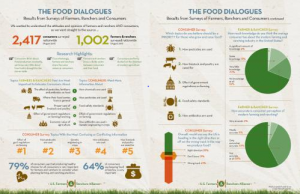
U.S. Farmers & Ranchers Alliance. Results from Surveys of Farmers, Ranchers and Consumers. Nationwide Surveys Reveal Disconnect Between Americans and Their Food. www.prnewswire.com/, 22 Sept. 2011. Web. 6 July 2017.
As we look at the changes due to the specialization of labor in the industrial food change there are many notable benefits. After all, because of the specialization of labor we are able to focus our attentions in many other areas and job markets, making our economy strong. And after all without it, we wouldn’t be taking this class, or making these blog posts! This is an example of nonlinear systems. Due to the specialization of labor, each individual has been able to focus on different particular parts such as jobs, research and education, and because of this specialization, the output is greater than the sum of its parts or individuals because of the synergy and process of working as a system.
In the short space of time from 1900 to 2000 we have shifted from having 60% of the labor force in food production to only 2%. But what does it mean that so few people know about farming? I would argue that there is a detrimental side to the industrialization of labor. People are getting more and more disconnected from where their food is coming from. A survey in Sep 2011 done by the U.S Farmers & Ranchers Alliance, showed that 72% of American consumers knew nothing about farming of ranching (U.S. Farmers & Ranchers Alliance). I believe the only reason why we have managed to get away with this mass ‘cheap’ food economy is because people are so disconnected with where their food comes from. 100 years ago, almost everyone would have known someone who worked in farming or food production. Now the majority won’t know anyone in that industry.
It is important that as consumers we act as citizens and get involved in the education process of farming starting at a young age and using our buying power to change the way our food is produced. To do this education will be key and it is important to start this at a young age. Programs like the Tilth Alliance (Tilth Alliance), and the Massachusetts Farm to School (Commonwealth of Massachusetts.) project are excellent starting points. The Tilth Alliance is where local school kids can go and find out how their food is grown and spend a day learning about the production and tasting foods. And the Farm to School nonprofit LLC in Massachusetts provides a win win situation to schools and farmers by giving local farmers the ability to sell their products to schools not only providing healthy local foods for the children but also marketing themselves to local families. There needs to be a greater focus of building these types programs and on the importance of real food, as Michael Pollan would define it in his book In Defense of Food. By starting these at a young age and ensuring that every member of society are aware of food production and the need for sustainable nutrient filled real food people will be able to use their buying power to support local sustainable farms.
Works Cited
Commonwealth of Massachusetts. Energy and Environmental Affairs . 2017. http://www.mass.gov/eea/agencies/agr/markets/farm-to-school/. 11 July 2017.
Tilth Alliance. Tilth Alliance Where Good Food Grows. n.d. http://www.seattletilth.org/learn/kids/kids-and-families. 11 July 2017.
U.S. Farmers & Ranchers Alliance. http://www.prnewswire.com/news-releases/nationwide-surveys-reveal-disconnect-between-americans-and-their-food-130336143.html. 22 Sep 2011. 6 July 2017.
